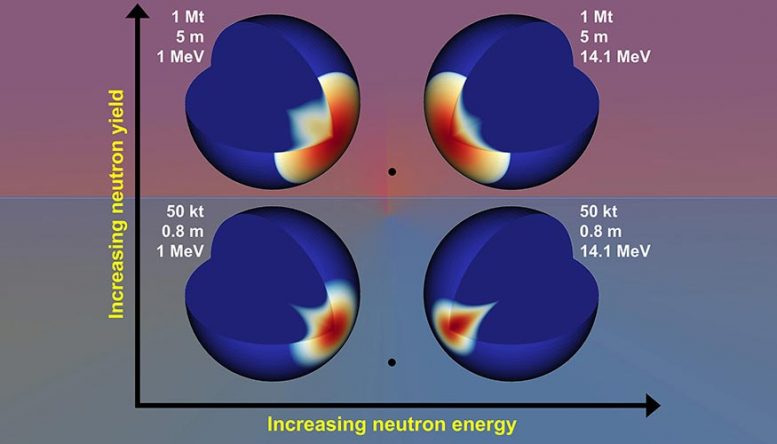
A standoff detonation of a nuclear device irradiates an asteroid and deposits energy at and beneath the surface. In this work, two neutron yields (50 kt and 1 Mt) and two neutron energies (14.1 MeV and 1 MeV) were the primary case studies compared side-by-side. The black dots represent the location of the standoff nuclear device. The colors in the asteroids show the intensities and distributions of differing neutron energy depositions. The dark blue color indicates where the asteroid remains solid. All other colors are where material is melted and/or vaporized, which allows for blow-off debris to be ejected, changing the asteroid’s velocity and deflecting it. Note that the asteroid considered in this research was 300 meters in diameter, but the visuals above show much smaller asteroids with 0.8m and 5m diameters — this is solely for the purpose of visualization, to enlarge the area of the energy deposition. Credit: LLNL
A research collaboration between Lawrence Livermore National Laboratory (LLNL) and the Air Force Institute of Technology (AFIT) investigates how the neutron energy output from a nuclear device detonation can affect the deflection of an asteroid.
Scientists compared the resulting asteroid deflection from two different neutron energy sources, representative of fission and fusion neutrons, allowing for side-by-side comparisons. The goal was to understand which neutron energies released from a nuclear explosion are better for deflecting an asteroid and why, potentially paving the way for optimized deflection performance.
The work is featured in Acta Astronautica and was led by Lansing Horan IV, as part of a collaboration with LLNL’s Planetary Defense and Weapon Output groups during his nuclear engineering master’s program at AFIT. Co-authors from LLNL include Megan Bruck Syal and Joseph Wasem from LLNL’s Weapons and Complex Integration Principal Directorate, and the co-authors from AFIT include Darren Holland and Maj. James Bevins.
Horan said the research team focused on the neutron radiation from a nuclear detonation since neutrons can be more penetrative than X-rays.
“This means that a neutron yield can potentially heat greater amounts of asteroid surface material, and therefore be more effective for deflecting asteroids than an X-ray yield,” he said.
Neutrons of different energies can interact with the same material through different interaction mechanisms. By changing the distribution and intensity of the deposited energy, the resulting asteroid deflection also can be affected.
The research shows that the energy deposition profiles — which map the spatial locations at and beneath the asteroid’s curved surface, where energy is deposited in varying distributions — can be quite different between the two neutron energies that were compared in this work. When the deposited energy is distributed differently in the asteroid, this means that the melted/vaporized blow-off debris can change in amount and speed, which is what ultimately determines the asteroid’s resulting velocity change.
Defeating an asteroid
Horan said there are two basic options in defeating an asteroid: disruption or deflection.
Disruption is the approach of imparting so much energy to the asteroid that it is robustly shattered into many fragments moving at extreme speeds.
“Past work found that more than 99.5 percent of the original asteroid’s mass would miss the Earth,” he said. “This disruption path would likely be considered if the warning time before an asteroid impact is short and/or the asteroid is relatively small.”
Deflection is the gentler approach, which involves imparting a smaller amount of energy to the asteroid, keeping the object intact and pushing it onto a slightly different orbit with a slightly changed speed.
“Over time, with many years prior to impact, even a miniscule velocity change could add up to an Earth-missing distance,” Horan said. “Deflection might generally be preferred as the safer and more ‘elegant’ option, if we have sufficient warning time to enact this sort of response. This is why our work focused on deflection.”
Connecting energy deposition to asteroid response
The work was conducted in two primary phases that included neutron energy deposition and asteroid deflective response.
For the energy deposition phase, Los Alamos National Laboratory’s Monte Carlo N-Particle (MCNP) radiation-transport code was used to simulate all of the different case studies that were compared in this research. MCNP simulated a standoff detonation of neutrons that radiated toward a 300 m SiO2 (silicon oxide) spherical asteroid. The asteroid was divided by hundreds of concentric spheres and encapsulated cones to form hundreds of thousands of cells, and energy deposition was tallied and tracked for each individual cell in order to generate the energy deposition profiles or spatial distributions of energy throughout the asteroid.
For the asteroid deflection phase, LLNL’s 2D and 3D Arbitrary Lagrangian-Eulerian (ALE3D) hydrodynamics code was used to simulate the asteroid material’s response to the considered energy depositions. The MCNP-generated energy deposition profiles were imported and mapped into the ALE3D asteroid in order to initialize the simulations. The resulting deflection velocity change was obtained for various configurations of neutron yields and neutron energies, allowing for the effect of the neutron energy on the resulting deflection to be quantified.
One small step for deflection
Horan said the work is one small step forward for nuclear deflection simulations.
“One ultimate goal would be to determine the optimal neutron energy spectrum, the spread of neutron energy outputs that deposit their energies in the most ideal way to maximize the resulting velocity change or deflection,” he said. “This paper reveals that the specific neutron energy output can impact the asteroid deflection performance, and why this occurs, serving as a stepping stone toward the larger goal.”
Horan said the research showed that precision and accuracy in the energy deposition data is important. “If the energy deposition input is incorrect, we should not have much confidence in the asteroid deflection output,” he said. “We now know that the energy deposition profile is most important for large yields that would be used to deflect large asteroids.”
He said if there were to be a plan to mitigate a large incoming asteroid, the energy deposition spatial profile should be accounted for to correctly model the expected asteroid velocity change.
“On the other hand, the energy coupling efficiency is always important to consider, even for low yields against small asteroids,” he said. “We found that the energy deposition magnitude is the factor that most strongly predicts the overall asteroid deflection, influencing the final velocity change more than the spatial distribution does.”
For planning an asteroid mitigation mission, it will be necessary to account for these energy parameters to have correct simulations and expectations.
“It is important that we further research and understand all asteroid mitigation technologies in order to maximize the tools in our toolkit,” Horan said. “In certain scenarios, using a nuclear device to deflect an asteroid would come with several advantages over non-nuclear alternatives. In fact, if the warning time is short and/or the incident asteroid is large, a nuclear explosive might be our only practical option for deflection and/or disruption.”
Reference: “Impact of neutron energy on asteroid deflection performance” by Lansing S. Horan IV, Darren E. Holland, Megan Bruck Syal, James E. Bevins and Joseph V. Wasem, 4 March 2021, Acta Astronautica.
DOI: 10.1016/j.actaastro.2021.02.028


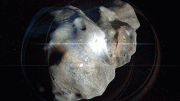
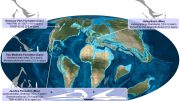

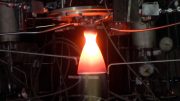


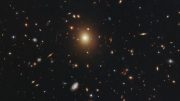
Stupid question. Wouldn’t it be enough to just hit it with a 100-500kg mass at a long enough distance?
… a very strange idea, would it be possible to make a change on earths path in order to avoid an asteroid, too…
… or to send an small rocket that will tug an asteroid, perhaps…
Would it make sense to send out a nuke rocket now before any threat as it could be out there ready to protect us early which should give us a better chance of success
We need to stop thinking about blasting everything. That’s a stupid idea that may trigger other problems. Perhaps the safest way will be to divert the asteroid by deviating it’s trajectory towards our moon or any other closest uninhabited planet.
I would think push rockets would be a more effective means of deflection. Unless there just isn’t time. Very risky maneuver
The nuke/s in orbit ready idea is probably in of the best suggestions. Maybe they are assembled in orbit to mitigate any potential disaster should a rocket fail on the way out of out atmosphere?
What about (de|ac)celeration?
That could have much more effect in the asteroid orbit, sending it to outer / inner ranges